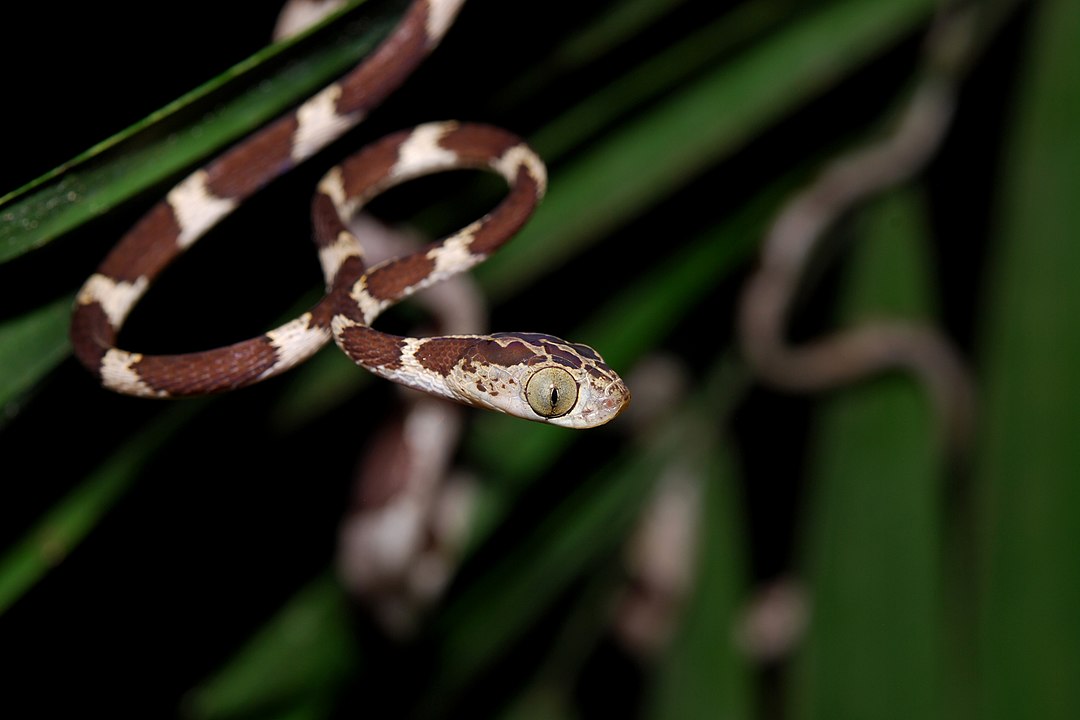As the name suggests, the Blunt-head Tree Snakes are characterized by their relatively large head with a blunt tip. These arboreal snakes have a slender body, and are nocturnal by nature. They have rear fangs and are mildly venomous; however, they are not considered dangerous to humans.
This slender snake blends in well with vines and other plant material while climbing among the trees in search of prey.
Blunt-Head Tree Snake (Imantodes cenchoa) common names – fiddle-string snake, slug head snake, is a species of rear-fanged colubrid snake distributed in Mexico, Central America, and South America (Guyana).
Description Of The Blunt-Head Tree Snake
These snakes have long, slim bodies and very thin necks, with large heads. Their eyes, which have vertical pupils, account for approximately 25% of the length of the head and protrude from the side of the head, enabling them to look downward. Snout to vent length for this species is generally around 800 millimetres, but can reach over 901 millimetres, total body length can exceed 1 meter. This snake has an adaptive, enlarged middorsal scale row, which provides stability when climbing.
Blunt-Head tree snakes are primarily white ventrally and pale brown dorsally. The dorsal surface is overlaid with 29-56 dark brown blotches (the number of dorsal blotches varies across this species’ range). These snakes have rear fangs.
The ventral surface, or stomach, of the snake is mostly white while the dorsal surface, or top, is a light or pale brown with lateral dark brown patches that begin at the head and continue down the length of the snakes’ body.
Habitat Of The Blunt-Head Tree Snake
They are found in Central America (eastern Mexico to Panama) and throughout the coastal countries of northern and western South America (Venezuela, Columbia, Ecuador, Peru, Bolivia, French Guiana, Guyana, Brazil, Paraguay, Peru, and Argentina), as well as the islands of Trinidad and Tobago.
Blunt-Head tree snakes occupy primary and secondary growth forests as well as plantation areas in lowland moist and wet forests. They also occur in premontane wet forests and rainforests, as well as lower montane wet forests and rainforests. These snakes are arboreal, often found in low vegetation including coffee trees and bromeliads, and can be found up to 2000 meters above sea level (most often 1500 meters or below).
Diet Of The Blunt-Head Tree Snake
Blunt-head tree snakes are carnivores that forage primarily at night. They feed mostly on small lizards, frogs, and other reptile eggs. Because the female blunt head tree snakes tend to have larger heads, they are capable of preying on larger reptiles and amphibians. Blunt head tree snakes are rear-fanged and mildly venomous, but is not considered dangerous to humans.
Behaviour Of The Blunt-Head Tree Snake
Blunt-head tree snakes are nocturnal, arboreal snakes. During the day, they may be found resting in a coiled position in shaded bromeliads, between coffee tree leaves, at tree bases, and in leaf litter. They are noted to prefer shaded resting places. At night, these snakes forage, primarily from ground level up to two meters, throughout various forms of dense vegetation (vine tangles, bushes, small trees). This species is fairly active at night and has been found, in captivity, to travel an average of 5-10 meters in 5 minutes. Although arboreal, they will readily travel across the forest floor. They tend to be docile and solitary outside of breeding season, and are not known to bite humans.
Reproduction Of The Blunt-Head Tree Snake
Blunt-head tree snakes generally exhibit continuous reproduction. However, in areas that have seasonal rainfall, egg laying and hatching is found to correlate positively with local wet seasons; for example, in Guatemala and Mexico, eggs are laid in June and July, with hatchlings appearing in July and August, corresponding with the wet seasons of these countries. In Brazilian rainforests, continuous reproduction occurs; vitellogenesis (yolk production) takes place from September through November or December, eggs are laid from November through January, and hatchlings appear from March through August. These snakes are oviparous. An average clutch will contain 2-3 eggs; clutch size is dependent on factors such as female body size, habitat and feeding habits. Female blunt-head tree snakes reach sexual maturity at about 620 mm SVL; males mature around the same size, typically about two years after hatching.
Blunt-Head Tree Snake
Found in Central and South America, these amazing snakes blends in well with vines and other plant material while climbing among the trees in search of prey. They are carnivores that forage at night. Found in Guyana dense rainforest, these snakes are truly wonders of creation!
Article References:
- https://animaldiversity.org/accounts/Imantodes_cenchoa/
- https://www.inaturalist.org/taxa/29873-Imantodes-cenchoa
- https://en.m.wikipedia.org/wiki/Imantodes_cenchoa
- Main Image: By Geoff Gallice – https://www.flickr.com/photos/dejeuxx/5193767358/, CC BY 2.0, https://commons.wikimedia.org/w/index.php?curid=12150097







